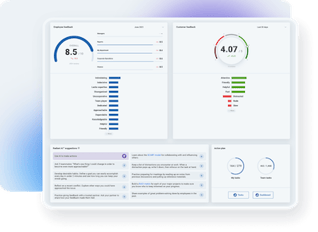
How to Reconcile Anonymous Feedback with Transparent Leadership
According to David W. Ballard, the head of the APA’s Center for Organizational Excellence, “It’s clear that an organizational culture that promotes and supports openness, honesty, transparency, and trust is key to a healthy, high-performing workplace.”
Anonymity allows employees to tell the full truth of their work experiences so that leaders can focus on the follow-up. But how can modern business leaders demonstrate a willingness to discuss and act on feedback?
In this article, we address common missteps managers encounter in their feedback approach and offer strategies for establishing a culture of honesty and transparency in the workplace.
What are the Biggest Misconceptions About Reconciling Feedback in the Workplace?
83% of rising Gen Z talent reports that they look for a mentor in a new employer. Going beyond the conventional employer-employee paradigm requires an environment of continuous feedback and learning. Yet broaching criticism can be difficult as many managers lack transparency in their assessments of individual workers.
Workers pick up on this. According to a Gallup survey, only 23% of employees strongly agree that their leadership is trustworthy. This negatively impacts their engagement in the workplace, which trickles down to their productivity and the business’s ROI.
To prevent employees from disengaging, consider these common misconceptions with delivering feedback:
Misconception #1: The details aren’t important
Often, managers might opt for a generalized approach when offering feedback. It's valuable to distinguish between a vague admonishment like “you need to improve” versus a specific suggestion such as “your work would improve by enhancing communication frequency with your team.” This shift not only clarifies the feedback but also provides actionable advice, making the guidance more useful and applicable.
Both these examples are constructive feedback, but only the second gives actionable advice on how the employee can improve their situation. Employees want to improve – this is fundamental to their engagement in a growing business. Almost nine in ten millennial employees value upskilling and career growth in their jobs, leading to higher retention rates among businesses that can offer them.
The opposite is also true. Employees who are praised and criticized too broadly may feel that their actions don’t matter. Nuanced feedback that takes the context of the situation into account benefits workers more than one-size-fits-all performance management assessments.
Misconception #2: Direct questions are better than open-ended ones
There are three parts to effective workplace feedback: context, action, and impact. The employee receiving the feedback should know what behavior the feedback addresses, what they can do to improve, and how it will impact their workplace.
Many managers resort to questions that are too limited and direct. Open-ended questions that emphasize the worker’s perspective and beliefs strike a better balance between reinforcement and criticism.
As an example, consider the difference between asking if unwelcome comments about appearance make a worker uncomfortable and asking if they feel respected in their workplace. Workers are individuals with diverse perspectives that inform their responses. A single approach to questioning does not fit all when addressing the nuances of worker feedback.
Open-ended questions allow workers to express their views so managers can foster a collaborative environment using these perspectives.
Misconception #3: Transparency is risky
According to the Army Leadership Field Manual, “Being transparent and professional are not mutually exclusive.” Yet, many managers feel that feedback transparency places their management workflow at risk. Will employees game the system? Will they fail to respect managers they feel too close to?
In the reality of the post-pandemic workforce, employees value transparency and honesty. They desire technology that makes it easy to collaborate with their peers as well as employers who are willing to honestly assess their performance.
While some employees will be resistant to transparency or fear the sharing of sensitive information, employers should strive to maintain trust in their workplace. This starts with transparency.
Strategies for Maintaining Transparency in the Workplace
Transparent feedback in the workplace is essential yet often misunderstood, accompanied by several challenges. To navigate these complexities, managers are encouraged to adopt unified approaches that intertwine employee engagement with performance management effectively.
Whether leveraging advanced software tools or relying on more traditional methods, these strategies are pivotal for boosting engagement, elevating productivity, and ultimately, enhancing customer satisfaction. By fostering an environment of open communication, businesses can unlock new levels of success and foster a culture of trust and mutual respect.
Give Feedback to Every Employee
“Everyone has to contribute, or they become laborers.” Walt Disney said that, and he was right. His namesake company still practices his theory of inclusion and transparency.
In a time when animation was a specialized industry with large skill gaps and little information sharing, Disney established a transparent workplace where workers were encouraged to share their perspectives. This evolved into a mentoring program (an industry-first) that fostered talent from its beginnings to its highest potential.
This de-emphasized seniority and emphasized collaboration. It’s a premise still used by the company today in its feedback process, which emphasizes the individual as the standard for accountability and growth.
An employee survey with anonymous 360-degree feedback translates Disney’s premise to the modern workplace. By including input from managers, peers, subordinates, and other departments, 360-degree feedback succeeds in providing the three pillars of great feedback (context, action, input).
Rather than dole out generalized feedback, top-performing companies like Disney tailor feedback to the potential, problems, and goals of the single worker. The feedback may be anonymous, but it doesn’t have to be impersonal.
Share Results with Employees
According to Gallup research, only 26% of employees strongly believe that their workplace feedback improves their work. In some cases, businesses don’t even share feedback results with employees – they simply use them to fuel analytics. This is a mistake since a culture of transparency, one where employees can see the direct impact of their actions, engages employees in their performance.
By sharing results in a meeting or on the company’s network, managers can discuss feedback and open the door to questions from the employees. This makes them feel that their concerns are addressed while receiving constructive feedback about their performance.
In this way, anonymous feedback becomes a three-part dialogue between employees and their colleagues, employees and their managers, and employees and themselves. Remember to encourage transparency in the way the feedback is delivered, such as with advance notice, prompt responses, and finalized feedback that doesn’t require censoring.
Feedback loses its relevance over time, so prompt responses and consistent communication help maintain the atmosphere of transparency managers should strive for
Measure the Results
Consider the example of the “silent superstar,” the employee who provides a productive influence in the workplace without demonstrating conventional outgoing leadership traits. With 360-degree feedback, a silent superstar scores much higher with coworkers than managers. This distinction is invisible in normal performance reviews.
The category of “silent superstars” includes good leaders who struggle to effectively manage a specific team, managers who are ready for a larger team, and workers who are flight risks if they don’t receive transparent recognition. In all cases, managers benefit from detecting and responding to these employees’ needs.
With this 360-degree feedback, managers gain the tools necessary to delve deeper into workplace engagement through additional metrics. Utilizing employee engagement surveys and turnover rate analyses offers insights into both the root causes behind the feedback and its influence on productivity. This comprehensive understanding is crucial for addressing any identified issues effectively.
Furthermore, a performance management system that can collect and measure these impact studies future-proofs businesses against changing employee expectations and competition from more inclusive workplaces.
How Can a Performance Management System Help?
A centralized performance management system that can conduct 360-degree feedback surveys keeps employees meaningfully engaged in their performance assessments, both positive and negative. Today, systems enabled with AI integration can even analyze feedback and generate personalized development plans for each employee.
In this way, modern performance management systems set a new standard for workplace transparency. Not only can employees anonymously express their perspectives, but they can also receive personalized roadmaps for their career progress based on their performance.
Moving forward, especially as more employees transition to remote work options, this continuous feedback dialogue will be key to maintaining engagement and transparency in the workplace.
Macorva helps companies increase employee engagement with pulse surveys and unlimited 360-degree feedback. Discover how our employee feedback solutions can transform your workplace. Explore Macorva now.





